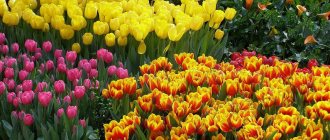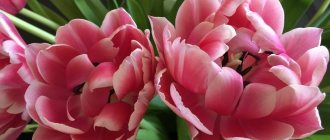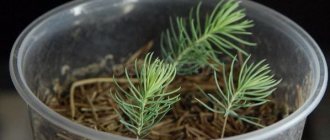Types of tulip flower beds
You can place several flower beds of different styles on the site. Based on their location, flower beds are divided into central and side. Based on this, choose the size, shape, and frame of the flower bed. Types of composition:
- Regular - a flower bed of regular geometric shape with symmetrical patterns converging towards the center.
- Elevated - a flower arrangement created on an elevation in the enclosing structures.
- Vertical - containers raised above the ground are used for planting.
- Mixborder is a flowerbed of irregular geometric shape, containing annual and perennial plants.
- Rockery is a rocky garden of a small area.
- Border - a form limited along the contour by an even decorative stripe of lower flowers.
- Arabesque is a figured flowerbed of an unusual shape (flower, animal, insect).
- Parterre - a pattern of low hedges, the space between which is filled with flowers.
- Rabatka is a narrow flower bed along garden paths, fences or fences.
Combined
Landscape design uses combinations of tulip beds with other flowers and ornamental plants. Properly selected neighbors will emphasize the tenderness and charm of spring flowers. Other plants will hide faded leaves and stems. Pairs well with tulips:
- hyacinths, forget-me-nots, pansies, daisies, primrose;
- bright blue muscari;
- lush fern or hosta;
- shrubs of louisiania, forsythia, early flowering rhododendron, weigela;
- conifers or boxwood.
Flowerbed of continuous flowering bulbs
A beautiful flower bed, continuously blooming from spring to late autumn, will decorate the garden. It is not completely covered with flowers - there are always green islands of plants opening buds at different times. The color scheme of a flower bed with tulips changes several times during the season:
- white snowdrops and blue spring crocuses will be the first to bloom;
- they will be replaced by yellow daffodils and hyacinths of all possible colors, including purple and white;
- then red tulips, blue-violet muscari, white and pink anemones, blue chionodoxes, bright yellow golden crocuses bloom;
- then comes the time of reticulated irises - white, yellow, lilac, violet, blue;
- Peonies and daylilies bloom in May–June;
- in July–August the garden will be decorated with begonias, callas, sparaxis, gladioli, and dahlias;
- Freesias, cyclamen and autumn crocuses bloom before the cold weather.
Varieties of tulips for flower beds
Of the variety of varieties, there are 4 main groups, including 15 classes of tulips. These are early-, mid-, late-flowering wild varieties suitable for rockeries, which appeared thanks to crossing.
- Early flowering – late April – early May:
- Simple early ones – Pink, Flair, Hadley. These are flowers that have the shape of a glass, shades of red or yellow. They are used for planting on borders and forcing.
Tulips Flair
- Terry early - Abba, Monsella, Verona. The varieties have low peduncles with bright flowers. They are used for forcing, growing in containers, baskets, on pallets or in the first lines of flower beds.
Abba
- Medium flowering – early – mid May:
- Triumphant – Akela, Oscar, Purple Prince. Their difference is goblet-shaped flowers of various colors (from white to dark purple). The varieties are used to create urban flower beds, parks, gardens, and are suitable for cutting and forcing.
Oscar
- Darwinian hybrids – Apeldoorn, Oxford, Parade. These are hybrid varieties with flowers of red or pink shades, less often - two-colored. They are grown in gardens, parks, and country houses. Flowers are used for forcing and stand cut for a long time.
Apeldoorn
- Late flowering – second half of May:
- Simple late ones - Avignon, Shirley, Primavera. These are tall varieties with large, goblet-shaped flowers with a square base and blunt-tipped petals. Such plants are used in any type of planting, used for forcing and cutting.
Avignon
- Terry late ones - Wirosa, Casablanca, Bonanza with filled double peony-shaped flowers. There are different shades, including white and black, some varieties are two-tone. These are suitable for growing in gardens, park areas, and in areas protected from the wind.
Wirosa
- Liliaceae – West Point, Maytime, Ballade. Flowers in the shape of a lily with pointed, bent petals of various shades. They are used for cutting, forcing, landscaping gardens and parks.
West Point
- Fringed - Lambada, Canasta, Maja. Beautiful varieties with sharp fringe on the edges of the petals, creating the illusion of frost on flowers of any shade (from white to purple). The purpose of the plants depends on the varieties crossed when breeding the hybrid.
Lambada
- Green-flowered – Artist, Greenland, Florosa. The flowers are large, with narrow petals of an unusual green color on the back, which persist throughout the flowering period. Varieties are used in dachas, garden plots, and to create unusual bouquets.
Greenland
- Rembrandt tulips – Ice Follies, Sorbet, La Courtine, Mona Lisa, Princess Irene. They are distinguished by large, goblet-shaped, variegated buds. Flowers are suitable for cutting and planting in flower beds.
Ice Follies
- Parrots – Rococo, Texas Gold, Fantasy. The height of the peduncle is 45–65 cm. Tulips with unusual flowers, the petals of which are deeply cut at the edges or have strong waves and resemble bird feathers. Varieties are used for planting along paths.
Texas Gold
- Wild species and varieties of tulips are obtained by crossing varieties from the first three groups.
- Kaufman – Cluck, Fashion, Showwinner. Low-growing flowers with large, elongated, star-shaped buds in the open state of various shades of pink, red and yellow. The varieties are used for planting in rock gardens and alpine hills, in borders and tree trunks.
Showwinner
- Foster - Madame Lefeber, Orange Brilliant, Sweetheart. The flowers have predominantly red buds that are cup-shaped. Tulips are grown in alpine hills, flower beds and borders.
Madame Lefeber
- Greig - Ali Baba, Pinocchio, Toronto. Low-growing flowers with large red, orange or two-color buds with recurved petals. They are perfect for planting in the garden and on a summer cottage in a flower garden, border, or on an alpine hill.
How to plant tulips beautifully
In a flower garden, plants should not interfere with each other. To ensure that the bulbs feel fully and comfortably, plant them in 10 cm increments in the row. Maintain a distance of 25 cm between the rows. Per 1 sq. m need about 100 bulbs. When you plant varieties of different heights, place low tulips on the south side.
Growing tulips in trays or baskets is very convenient. This:
- will simplify care;
- protects the bulbs from damage;
- will allow you to remove faded plants from the flowerbed for ripening.
A beautiful flower bed of tulips - an example
Choosing a place for a flower bed
Growing tulips in the country should begin with determining the site. Bulbous plants are demanding on soil. Plant perennials in sandy loam, humus-rich, slightly alkaline or neutral, loose, well-drained soil. Requirements for a site for a flower bed:
- good lighting;
- protection from strong winds;
- Smooth surface;
- permeable subsoil layer;
- fertile layer at least thirty centimeters thick;
- a suitable predecessor (any crop, excluding bulbous and nightshade crops).
Planting scheme
To create a specific pattern from tulips, draw a diagram, then transfer the markings to the flowerbed. It will help you avoid mistakes and immediately achieve the desired pattern. You can effectively arrange tulips on your site:
- groups - 10–15 bulbs of the same variety or color;
- in height - in the center or in the background - tall flowers, then - medium, in front or along the edge - low;
- according to the timing of flowering - with alternation of early and late flowering plants;
- multi-layer planting - plant late-flowering bulbs deeper, then mid-flowering varieties and behind them - with early flowering.
Color combination
When creating a planting scheme, think about what colors and shades you want to see in the flower garden. Types of composition in landscape design:
- Monochrome - a combination of tulips of the same color, but of different types (simple, terry, fringed and others).
- Contrasting - the use of pure tones located on opposite positions of the color spectrum (yellow with violet, green with burgundy, orange with blue).
- Close in shade - a combination of shades that smoothly replace each other, adjacent in the spectrum (pink, blue, lilac or red and burgundy, transitional color - white).
- Neutral - the use of discreet, neutral shades (white and green, green with pink or blue).
General rules for forming a flower garden or flower bed
In landscape design, there are a lot of rules and secrets for creating a harmonious flower garden.
Here the requirements of the plants themselves must be taken into account - you need to try to select flowers with the same requirements for lighting, soil composition and frequency of watering, so as not to cause them discomfort during the process of growth and development.
Here it is important to take into account the size and shape of both the flowers themselves and the plant as a whole - so that they do not interfere with each other, for example, strongly shading or interfering with the root system of the “neighbor”.
Here it would be nice to know the timing of flowering - regardless of whether you are planning a flowerbed of continuous flowering, where some flowers would replace others, or an option with bright colors only for a certain period of time and lush greenery for the rest of the time period.
Here you need to remember that some plants can oppress others due to their size or active consumption of resources or, conversely, protect them from certain pests and help them actively develop.
This certainly touches on the issue of successful color combinations and avoiding both excessive, eye-straining variegation, and boring, boring options.
- How to correctly combine plants in a flower bed by color
Don’t know how to combine colors in a flowerbed so as not to go to extremes - clumsy or plain? We'll tell you!
In addition to all this knowledge, it would be nice for a novice gardener to know that in landscape design there are entire schemes of the most successful plantings, each of which has its own rules of organization. For example, according to their location on the site, flower beds can be lateral, vertical or central; in shape – regular and raised; by color - monochrome, contrasting and tint, etc. The density of plantings, the height of plants, and the color of their leaves are also taken into account - just planting the first seeds and bulbs you come across nearby will not be the best idea, believe me.
Now let's talk in more detail about the most favorite garden flowers - what combines best with what?
What to do with tulips after flowering
Tulips in the country can grow in one place for 3 seasons, but the quality of the flowers deteriorates over time. Caring for faded tulips is as follows:
- when the petals have dried and fallen off, cut off the peduncle so that the bulb does not become depleted;
- For several weeks after cutting the heads, water generously and loosen the soil;
- feed the tulips with mineral phosphorus-potassium fertilizer;
- As soon as the leaves turn completely yellow, dig up the bulbs (preferably on a warm, sunny day);
- Clean the dried bulbs from soil, stems, and hard outer skin; discard rotten and unsprouted bulbs; treat those affected by fungus with a fungicide;
- Place the bulbs in mesh boxes in one or two layers, store in the basement, pantry, cellar at a temperature:
- in July – 25 °C;
- in August – 20 °C;
- in September – 17 °C.
Daffodils.
We plant it in a flowerbed.
In the fall, choose a location to plant the bulb. Partial shade, or that part of the garden that receives soft morning rays but is protected from the hot afternoon sun, is ideal. Dig a hole about 20 centimeters deep and mix the soil in it with compost. It is very useful to add a little wood ash to the hole for good plant development.
Bury the bulbs so that about 5 cm of soil covers their heads, and the distance between them is at least 10 cm. Water them thoroughly (about 40 minutes with a hose with a sprinkler attachment) every four days, depending on the weather. This is important for successful seedlings. Keep the soil moist - a layer of mulch will help reduce water evaporation and you can water less.
There is no need to feed daffodils while they are growing; do this after flowering with a complete fertilizer in a 3:1:5 ratio so that they can retain nutrients until next season. Complex mineral fertilizers contain the optimal amount of useful microelements that are suitable for almost all plants. These are ammophoska, azofoska and nitrophoska, known to all gardening lovers. In addition to them, stores sell special complex fertilizers selected for certain types of plants - potatoes, strawberries and other crops.
After the daffodils have finished blooming, you can dig them up to make room for other flowers and place them in a dry place at room temperature.
Planting in containers
All daffodils grow well in pots, especially dwarf varieties. For example, miniature Paperwhite daffodils work very well when planted on a windowsill that is not exposed to direct sunlight. This variety is excellent for growing at home. Its thick snow-white inflorescences look delicate and elegant on a kitchen window or table.
Variety Paperwhite
Choose a deep container with the expectation that you will bury your bulbs 2 inches deep and they should develop a strong root system.
Buy a special soil mixture or make it yourself by mixing sod, peat, compost humus and sand. The soil should be loose. In heavy soils, bulbs germinate and bloom less well. Drain the bottom layer of your container to remove excess moisture and reduce the frequency of watering.
It is best to plant daffodils in a checkerboard pattern. An interesting tip is to plant your bulbs at different depths or in two layers. First, stick one half of the seedlings into the ground, cover them with a layer of soil, then the other half and also sprinkle them generously with soil. You will get shoots of different height levels, and your composition will acquire a special charm.
An example of multi-tiered planting in a pot
We plant in the grass
To achieve the effect of daffodils growing naturally, as if on a forest lawn, plant the bulbs on the lawn and under trees. An early blooming carpet of sunny yellow will emerge before the thick green grass and leaves emerge. It's amazingly beautiful! Do not forget that the bulbs need to be watered as abundantly as when planting in a flower bed.
The "carpet of flowers" feels better under trees.
Plant next to other flowers.
There are several techniques, the use of which will allow daffodils to coexist harmoniously with certain plants.
First appointment. Color palette.
The best compositions are obtained by following the rules of the color wheel. Plant your yellow daffodils next to blue and purple plants for a bright and harmonious flower bed. These are, for example, muscari, periwinkle, chionodox, phacelia.
Reception second. Flowering time.
Plant next to daffodils only those plants that bloom at the same time as them - from April to May. These include the already listed muscari, periwinkle, chionodox, phacelia, as well as large-rhizome geranium, lungwort, and tulips.
Reception third. Annuals.
If you plan to dig up your daffodil bulbs after they have died, place similar early annuals near them. Then, in place of the primroses, you can plant later flowers, and you will again have a beautiful flower bed in the garden.
In conclusion of this topic, we would like to advise you to experiment with varieties. There are early flowering daffodils, and there are later ones. When varieties such as Flower Carpet, Paperwhite (good for containers) and Ice Follies begin to disappear, Akropolis and Delnasho will take the baton.
Late variety "Delnasho"
Tulips in garden landscape design - a guide to beautiful flower planting
To create a spring “vernissage” in the landscape design of the garden area and for decorating the interior of the premises in the house, early bulbous flowers are best suited: tulips, daffodils, crocuses and other crops. The bright palette of colors of these plants and spring greenery miraculously transform both large and small areas, creating comfort and coziness in the home.
On this page we will share our experience on how to beautifully plant tulips on a plot, show photos and recommend patterns for decorating oriental flower carpets. In them, tulips play a major role and are the center of any composition. Other plants, flowers and structures should only complement stylish design solutions and not compete with tulips.
Care instructions
Every gardener thinks not only about how to plant tulips beautifully, but also how to care for them so that their flowering is incredibly spectacular. So, when the first shoots appear, you should constantly monitor the soil moisture: from the appearance of buds until the moment when the flowering process stops. Recommended humidity is about 80%. At higher humidity the bulbs may rot, and at low humidity they may crack.
Like all plants, tulips and daffodils need feeding. It is produced in early spring, and it is advisable to combine it with watering. An effective fertilizing solution is the following solution: ammonium nitrate (15 g) mixed with superphosphate (20 g). This amount is needed per 1 square meter of land.
After the flowers stop blooming, it is better to cut them off. This will help retain enough nutrients. For tulips, not only the flower, but also the leaves are cut off so that only 2-3 leaves remain on the stem. From daffodils, only the flower is cut. There is no need to rush to dig. You need to wait until the leaves turn completely yellow. Otherwise, the plant’s reproduction function may decrease and its flowering may deteriorate. Store tulip and daffodil bulbs in a room with good ventilation and low humidity. The temperature should range from 20 to 25 degrees.
Regarding the beauty of the flower bed, it should be said that it is better to intersperse Triumph tulips and Darwin hybrids with tubular daffodils, since their flowering occurs at approximately the same time. Kaufmann tulips, which are early varieties, are preferably planted with cyclamen daffodil, which blooms in early spring.
To maintain the attractiveness of the flower bed, it is recommended to plant gypsophila nearby. Firstly, when the tulips and daffodils wilt, the flowerbed will look quite bright. Secondly, gypsophila takes excess moisture from the soil, which is destructive for bulbous plants.
In order for the flowerbed to smell fragrant until autumn, you need to know what to plant after the tulips. These can be both decorative foliage and flowering plants. However, their choice should be taken carefully, as some of them can displace bulbous ones. Spring bulbs and perennials that bloom in autumn get along well. These include sedum and autumn asters.
If the flowerbed is not located in the full sun, then after tulips and daffodils you can plant spirea on it. Some of the wild species of tulips are planted interspersed with aubrieta clumps, ground cover sedum, thyme and other cushion-shaped plants. All of them, like tulips and daffodils, love the sun and will make the flowerbed lively and colorful. In the space freed from these flowers, you can plant seedlings of flowers such as salvia, asters, marigolds, lobelia and ageratum.
Creation of landscape design
What the flower beds will look like in the spring, after the bulbs have awakened, needs to be thought out in the fall. Care should be taken to install forged and wicker fences, stonework, paved paths, fountains and other attributes to create not only flower beds, but also mixborders, ridges, alpine slides, and rocky gardens.
If novice gardeners do not yet have a collection of bulbs from other crops to develop planting schemes, and they do not know what to plant tulips with in a flower bed, we recommend thinking about creating Moorish lawns, where bulbous crops can be combined with cereal plants with wide leaves. You can create separate groups of bulbous plants and place them in tree trunks and large bushes. In public gardens and parks, landscape designers plant entire tracts and organize huge “festivals” of tulips, displaying all their splendor and diversity.
Let's take a closer look at how to distribute tulips in the garden and create a landscape design (photo), using some diagrams.
Rows of tulips
Bulbs are planted in a row if the garden plot is divided into zones where individual compositions and elements are repeated, that is, a regular and landscape garden is created and designed. Each section (zone) must have the correct geometric shape. On each of the square mini-beds, a crop of the same variety and color, the same flower shape and texture is planted. Then the composition will consist of different bright areas. It is fashionable to alternate tulips in a rectangular flower bed with other plants that bloom during the same period of time, for example, daffodils, creating an edging.
Border plantings
Border planting of bulbous plants is the most common. What is important here is the combination of tulips with other flowers in the flowerbed (border), since after the bulbs have finished flowering, the flowerbed will lose its spectacular appearance, especially with the lower leaves of the plants fading and drying up. They are left so that the bulbs gain strength and develop, and after replanting in the fall for the next season in the spring, they produce new healthy buds and greenery.
Annual or perennial crops are planted that bloom after tulips. Annual seedlings replace dug up bulbs, while perennial flowers will cover the drying leaves of tulips and “save” the beauty and contours of the borders.
Planting in groups
Group plantings always look more impressive if the tulips are the same color. If you mix different varieties, the flowerbed turns into a vinaigrette. If tulips are scattered one by one throughout the area among other flowers, then they will be invisible even with their magnificent appearance. Flowerbeds with tulips in the country (photo) can be made contrasting: one bright spot of color should gently transition from one tone to another. Monochrome flower beds of single-color tulips take on an attractive appearance, but the varieties should be different: simple and double, simple and fringed, simple and lily-flowered, etc.
Planting plants at the same height
To organize a flowerbed of crops of different heights, the background is planted with bulbous plants with tall stems, the middle part with a crop with medium peduncles, and the foreground with dwarf tulips and other low-growing species of flowering bulbous plants. The flowerbed can be multi-level or stepped, where the flowers do not overlap each other.
Combination of tulips with other plants
What flowers can be planted with tulips:
- Clearings can be decorated with small-flowered crocuses, quinodoxes, and arrays of muscari, dividing areas according to the same color scheme.
- The partners of tulips can be broad-leaved perennials, so bulbous ones are combined with daylilies, phlox, and geraniums, which can cover empty spaces with dry tulip leaves after flowering.
What to plant next to daffodils and tulips, for example, varieties such as Black Hero or Holland to create a spectacular flower garden:
- gray spirea as a background for Beauty tulips;
- gray spirea and steppe almond.
Anthracite tulips look spectacular against the backdrop of woolly clears and between daylilies. After thinking through color schemes, bulbous plants are planted as companions for ornamental shrubs: spring spirea Grefsteim, steppe almond, mahonia holly, chaenomilis japonica and spirea japonica, common lilac. Here you can choose lilac varieties according to color scheme and create contrasting or single-color compositions with tulips. The flight of fancy has no limits, so the bulbs are planted in the trunks of early varieties of cherries, apple trees and plums to create a bright extravaganza of flowering trees and bulbous crops.
Important . Plant bulbs must be planted at a distance of up to 15 cm from each other.
Flowerbeds with crocuses and tulips and other bulbous plants are often made round or elliptical in the form of a basket: they are braided with twigs. Or they take large baskets without a bottom and dig them into the ground in different parts of the garden. Sometimes onion gardens are created, where perennial culinary onions grow mixed with various bulbous flowers, including tulips. These could be daffodils or hazel grouse.
The beauty of the onion design can be enhanced by terracotta or fireclay figurines and ceramic tiles dug into the ground. If a bench with a transparent plastic or thick glass seat is installed in the garden, then low-growing varieties of bulbous crops are planted under and behind it. Decorate buildings: terraces, balconies, patios, entrances to houses or gazebos with flowerpots or flower pots with tulips.
You can create a composition with ornamental shrubs in the background: rhododendrons, Louisiana, weigela and conifers, and in the foreground make a green lawn and distribute bright bouquets of one-color or two-color tulips on it, located at a distance of at least a meter from each other. They are planted in pots, baskets or small squares of land.
If you plant the bulbs in the center of a compact flower bed, and frost-resistant crocuses around them, you will create a delicate lace around the edge of a romantic composition. Slender hyacinths with a charming aroma are planted mixed with tulips, taking into account the tones. In spring, tulips and rainbow irises blooming in April-May will create a festive atmosphere for 2 months.
How to form groups of plants
Most often, perennial flowering plants , including bulbous ones, are planted in groups. The size, number of crops and planting height are determined by the size of the flower garden, as well as the types of shrubs and trees that surround it.
To ensure that the lawn does not lose its decorative qualities throughout the season, it is necessary to plant annual and biennial crops instead of those that have already bloomed. Annuals do not form a large root system, so the layer of soil that is located above the bulbs will be enough for them to produce good flowers.
Read also Budleya in the Moscow region reviews
It is important to know! Plant such annual plants as salvias, cinerarias, petunias, zinnias, and marigolds in ornaments, having previously marked the pattern on the flowerbed.
When forming groups, shrub framing is usually done. Tree groups should be used according to the principle - light-leaved shrubs should set off plants with light flowers, shrubs and trees with dark foliage - crops with bright, richly colored flowers.
Groups of plants of the same type should be placed at a distance that takes into account the size of the growth of specific crops. Otherwise they will begin to oppress each other. So, for 1 sq.m of landing area take:
- from 1 to 3 pieces of tall plants,
- 5-10 pieces of medium height,
- 20-30 pieces of low-growing ones,
- up to 50 pcs of dwarf bulbous bulbs.
With such planting density, the plants will grow normally and produce bright, well-developed flowers.
Perennial flower bed - primroses, daffodils and tulip
Simple groups can include up to 2-3 species of any bulbous plant, regardless of their flowering time. In this case, tall tulips or daffodils are planted in the back of the lawn, and the shortest or most beautiful plants should go to the foreground. Thus, all components of the group should be clearly visible.
There are groups that select according to color and texture. For example, use pink tulips and rich blue forget-me-nots as the main plants, and for the border use low-growing red tulips combined with white daisies or dark blue crocuses with snow-white daffodils.
A group consisting of irises surrounded by primroses will look very impressive. Moreover, when planting irises, use multi-colored varieties. Primroses can also be planted in different varieties - in spots.
When forming a group, take into account the flowering time of bulbous perennials so that in the flower garden those plants that have already bloomed will be replaced by new ones whose flowering period is just beginning. This will give the flowerbed a different combination of colors at any time.
Different types of plants that bloom at different times are planted in mixed groups.
We hope that these simple tips will help you create a little paradise in your summer cottage, which will delight you with its appearance from early spring until autumn for many years.
To create a spring “vernissage” in the landscape design of the garden area and for decorating the interior of the premises in the house, early bulbous flowers are best suited: tulips, daffodils, crocuses and other crops. The bright palette of colors of these plants and spring greenery miraculously transform both large and small areas, creating comfort and coziness in the home.
On this page we will share our experience on how to beautifully plant tulips on a plot, show photos and recommend patterns for decorating oriental flower carpets. In them, tulips play a major role and are the center of any composition. Other plants, flowers and structures should only complement stylish design solutions and not compete with tulips.
Flower bed schemes
A small composition: round, square, oblong or angular with bright colors will attract the eye in the spring, until late autumn. Place it in the partial shade of trees or near the walls of buildings. Non-aggressive flowering and decorative foliage crops are selected for proximity to bulbous plants. They must be equally demanding in terms of lighting and soil moisture. The root system of the partners should be fibrous, loose and underdeveloped, since otherwise it will interfere with the development of vegetative processes in the bulbs. Such a root system is found in arabis, aubriet, phlox, forget-me-not, and sedum.
Approximate diagram of an elongated flower bed (number of plants in pieces):
- peonies are planted in the center of the composition - 3;
- to the left of peonies – tulips – 7;
- further – liatris – 2;
- behind it – cleaning – 3;
- at the left end – host – 3;
- to the right of the peonies – dotted loosestrife – 1;
- then rhizomatous geranium – 5;
- behind it - gaillardia - 1;
- further – crocuses – 10;
- at the right end - host - 3.
Approximate diagram of a round flower bed:
- in the center of the composition, red tulips are planted in the form of a small circle;
- a strip of yellow daffodils is made around the circumference;
- the next stripe in a circle of blue hyacinths;
- behind them is a strip of woodland and mouse hyacinth in purple tones.
To create a personal composition at your discretion, you can use the following plants:
- thuja western Smaragt;
- decorative mahonia holly with evergreen foliage and dark blue fruits; it is planted in partial shade so that it does not burn in the spring sun;
- hosts (at least 3 pieces) emerge at the moment of flowering of the tulips, but after the flowering phase and drying of the tulips they rise, show their beauty and cover empty spaces;
- tulips with an average flowering period of double varieties and yellow-orange or green colors;
- Muscari from small onions will complete the composition.
If the area to create the composition is small - approximately 5 m², then 5 varieties of crops are planted, no more. The border is made from low-growing bulbous plants. If the flower beds are made up of perennial plants: ferns, peonies, phlox, hostas, gypsophila, astilbe, then small islands are left for tulips. When the bulbous flowers wilt, the partners will cover the dry leaves and prevent the flowerbed from losing its spectacular appearance. Also read our article “When to plant tulips in open ground.”
When is the best time to plant daffodils?
Flower bulbs must be planted in the last days of September or in the first ten days of October, depending on weather conditions. The selected area should be well moistened. If autumn turns out to be dry and without rain, you should soak the soil well with settled rainwater.
Before planting, the soil must be loosened and saturated with fertilizing, for example, humus, compost, peat, superphosphate, and wood ash.
You cannot add fresh manure to the soil for planting bulbous flowers - the planted bulbs will get burned and die. It is also recommended to add a little river sand to the soil.
When the soil is moist and sufficiently saturated with nutrients, you can begin planting. First, you need to inspect and sort through all the onions, putting aside soft, diseased or damaged ones (with spots or cuts with a shovel). It is recommended that all healthy bulbs be disinfected for half an hour in a weak solution of manganese or fungicide.
A small hole should be prepared for the bulb, corresponding to approximately three of its diameters. The distance between the holes depends on whether you plan to plant flowers for 1 or 2 years, or for 4-5 years.
If you plan to dig them up in a couple of years, then you don’t have to worry too much about the fact that the bulb will produce a lot of babies and they will be crowded in the ground. Therefore, in this case, 7-10 cm between holes will be sufficient.
If a flowerbed with daffodils will remain in one place for 5 years, care should be taken to ensure that the little children that appear at the flower during this time have enough space and nutrients from the soil. Therefore, it is worth making holes every 15-20 cm from each other. After planting daffodils, it is necessary to cover the area with fallen leaves.
Description of the best varieties of lilac with photos and names
How to grow excellent petunia seedlings
- How to properly water an orchid in a pot: the benefits of automatic watering for the plant
Landing site design
In addition to the above, designers also offer several original solutions for planting tulips and daffodils:
- planting under trees (preferably fruit trees). You can create a hedge from almost any variety of tulips. It is preferable that the varieties are harmoniously combined in color and growth. According to experts, the best option would be Kaufman hybrids;
- A container garden is a chic option for decorating a terrace or a place to relax in the yard. In autumn, plant as many bulbs as possible in large or medium pots, and in spring they should be arranged in the desired area or placed in beautiful flowerpots;
- in the wheel of a car or cart;
- alpine slide. To create a rocky garden, low-growing species are better suited. It is better that the rock garden is located in a place that will receive the first spring sun rays. Designers recommend placing it near evergreen bushes;
- Daffodils look incredibly impressive in garden modules. These modules should be considered at the stage of flooring.
Narcissus in the house
Many people know about planting daffodils in open ground, but not everyone is aware that a delicate flower can be easily grown on a windowsill in your apartment.
To do this, in the fall you should prepare small containers with nutritious soil for flowering plants. Make a hole, plant the selected bulb, water it and move the pot to a cool place. Once every 2 weeks, the soil in the pot should be slightly moistened.
At the end of March, the onion already begins to sprout. From now on, it is recommended to move it to a warm and sunny place. After the bud appears, the temperature in the room should be reduced again.
The home flower daffodil does not like drafts. During the period of budding and flowering, it should be fed with a mineral mixture of fertilizers.
Daffodils always look graceful and attractive. Any plant variety is a small masterpiece of nature. With their flowering and beauty, they welcome spring and the approach of warm days.
Using a duet with other colors
Tulips can peacefully coexist in the same flower bed with other plants; moreover, even the most unexpected duets at first glance give excellent results and create stylish and original compositions. The main criterion for selecting potential neighbors of this bulbous plant is the similarity in requirements for lighting, moisture, as well as the composition and structure of the soil.
Most often, tulips are planted in the same area with other bulbous plants. This makes it possible to dig up the bulbs after flowering, and grow annuals in the vacated area. Tulips and daffodils look romantic and at the same time elegant in the same flower bed. The combination with crocuses and hyacinths looks very gentle and festive in a spring-like way.
It is also recommended to place tulips in flower beds with annual flowers with bright and abundant flowering (zinnias, petunias, asters, pansies). It is important that the roots of annuals are loose and shallow - this way they will not interfere with the development of the bulbs. Perennial neighbors for tulips can be hostas, peonies, gypsophila, and ferns. You can also plant tulips in the foreground, with ornamental shrubs such as weigela and rhododendron in the background.
Tulips are amazing spring flowers. Despite their short flowering period, many admire their beauty and diversity. With the right approach, you can create a real masterpiece of landscape design on your site.
Sources:
https://tytdacha.ru/tsvety-i-rasteniya/sadovye-tsvety/klumba-iz-tyulpanov/ https://sadim.guru/tjulpany-v-landshaftnom-dizajne-sada/ https://fermer.blog/ bok/cvety-i-rasteniya/cvety/narcissy/vyraschivanie-narcissov/14455-tyulpany-i-narcissy-v-landshaftnom-dizayne.html










